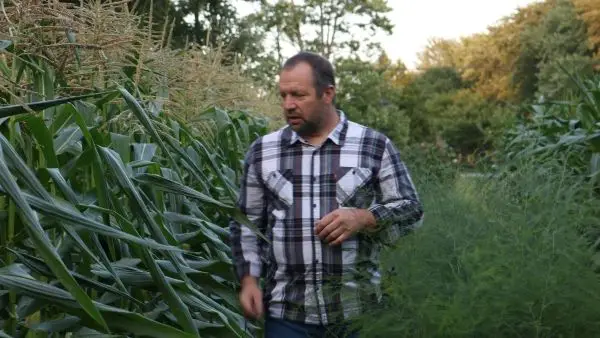So, you’ve caught the homesteading bug. Maybe you’re interested in starting a self-sufficient farm, complete with fields and livestock. Maybe you just want to do a little city-steading and grow some fresh food in a relatively small area. Whatever your goals or space, it’s a good idea to plan out what you’ll be planting before you jump headlong into homesteading. But what to plant?
There are lots of reasons to incorporate a variety of fruits into your planting. Few things compare to the crispness and strong flavor of fresh, homegrown fruit. Homesteaders have bills to pay like anyone else, and many fruits can be made into a variety of goods you can sell. Some can even double quite effectively as passive sources of animal feed. Here are 14 fruits that, conditions permitting, homesteaders should grow.
1. Apples
Apple trees make a great addition to a homestead for a host of reasons. For starters, apples pack a vitamin- and mineral-filled punch of nutrition, which likely led to the adage that “An apple a day keeps the doctor away.” Unwanted or misshapen apples make an excellent source of food for livestock or can be easily composted.
Apples grow well in most areas with good drainage, preferring full sun. You should plant at least two, space permitting, so that you don’t have to worry about selecting for self-pollination. Plus, twice the apples!
Roughly 2500 of the 7500 varieties of apple are grown throughout the United States. They vary in size and yield, as well as flavor profile and shelf life. Dwarf apple trees can be grown in large containers, even indoors with enough sun, and best suited to those with limited space.
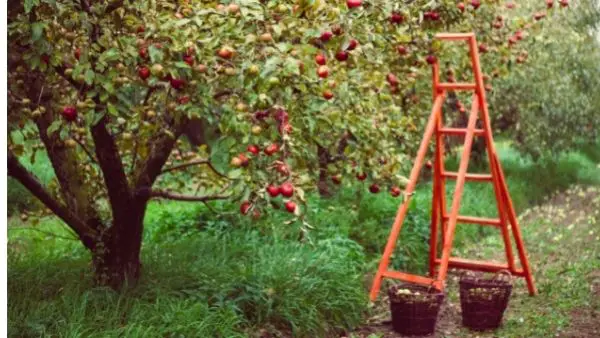
Full-grown dwarf apple trees can produce 3-6 bushels per harvest, while full-sized varieties produce 6-10 bushels per harvest. As such, even a small apple orchard on a homestead can produce a substantial amount of fruit.
Apples are also a highly versatile base fruit for a variety of products. You can bake them into pies, cook them down into apple butter, or press them into cider, all of which fetch decent prices at farmers’ markets and roadside stands.
Apple cider vinegar has a range of health applications, is a natural antiseptic, and can be used to preserve the other food your homestead produces.
| Variety | Uses | Zones |
|---|---|---|
| Golden Delicious | Snacking & Baking | 4-9 |
| Granny Smith | Snacking, Salads, Baking | 6-9 |
| Fuji | Snacking, Salads, Juice, Cider | 6-9 |
| Jonagold | Snacking | 5-8 |
| Gala | Snacking & Baking | 5-8 |
| McInstosh | Snacking & Baking | 4-7 |
| Honeycrisp | Snacking (one of my favorites) | 3-7 |
| Red Delicious | Snacking & Baking | 5-8 |
| Pink Lady | Snacking | 6-9 |
| Lodi | Snacking, Sauce, Baking | 3-8 |
| Braeburn | Snacking & Baking | 5-8 |
2. Pears
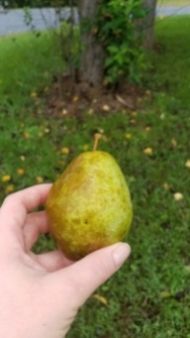
Pears are versatile growers and make a good addition to your homestead orchard. They can be grown from dwarf rootstock in containers or like bushes and can be trained to grow along lattices or walls.
There are many self-pollinating varieties, so you don’t necessarily have to have a pair of pear trees. This makes them great for homesteaders that have limited space to work with.
If you have plenty of space, though, planting a few pear trees is ideal, if only to take advantage of the increase in output. Like apples, pears are a nutritious addition to the diet.
They are great for canning in syrup and can then be stored for later use or sale. Full-sized pear trees each produce 150-200 pears per harvest. Even after you’ve eaten and canned as many as you want, there will likely be plenty of leftovers or undesirables for the animals to munch on!
Best pears to grow on the homestead:
3. Peaches
Peaches make a great choice of fruit trees for homesteaders in moderate climates. Peaches prefer full sun and are less hardy when compared to other stone fruit. If temperatures dip below –15° Fahrenheit, most varieties begin to lose new growth and die around –25° Fahrenheit.
A full-grown peach tree will produce about 100-150 pounds of fruit per harvest, so adding a couple of these to an orchard adds plenty of fruit to your homestead’s stores.
Peaches are also rich in nutrients, with a single peach containing about 15% of the vitamin C a person needs per day, as well as 6% of their vitamin A.
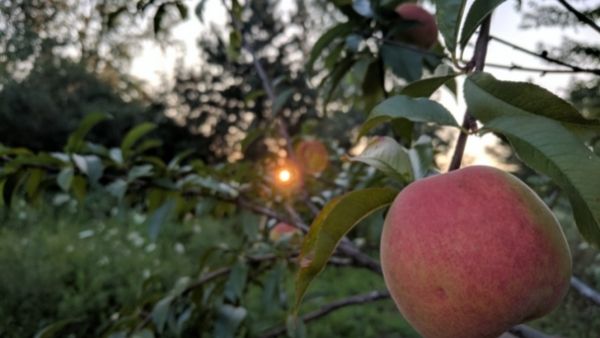
They can be canned in syrup, made into preserves, baked into cobblers, and just about anything else you can think of to do with fruit. Not only are secondary peach products varied, but they are also often highly desirable at farmers’ markets.
Some popular varieties are Red Haven, Reliance, and Elberta. Click the links to find them on Amazon.
4. Figs
Figs make a great food crop for your homestead. Figs can easily be grown in containers indoors year-round with full sun, careful pruning, and compost-based fertilizer, or overwintered inside in areas with cold winters. Common fig trees do not require pollination to produce figs and will produce 20-60 figs per harvest. They typically take a year or two to mature before they begin producing fruit.
Despite the smaller yield relative to other fruit trees, figs make a delicious addition to your homestead’s larder, going quite well in salads. They are also good eaten fresh or dried and have a very long shelf-life when dehydrated. No wonder Newton raved about them so much!
5. Plums
Plums are one of the easiest to grow of the stone fruit-bearing trees, given you’re in the proper climate. They don’t tolerate cold very well and maybe damaged by prolonged exposure to freezing temperatures.
They are suited best to sandy loam soil but are tolerant of a variety of soil types. They do not need pollination to produce plums, so planting a solitary plum tree makes for a great way to add some variety to your table.
They are suited best to sandy loam soil but are tolerant of a variety of soil types. They do not need pollination to produce plums, so planting a solitary plum tree makes for a great way to add some variety to your table.
Full-grown plum trees produce 50-80 pounds of fruit per year, so even a single tree can be a great asset on the homestead. While plums may not be the most prominent fruit, they are quite delicious and make good roughage for both you and the livestock. They keep well when canned in syrup or as preserves, so none need to go to waste.
6. Cherries
Cherry trees like colder weather but will tolerate many areas save for arid climates and areas that don’t provide the necessary two months of temperatures below 45°Fahrenheit. Without a period of cold, cherry trees will not produce fruit properly. Cherry trees to well in light, sandy soils. They do need to cross-pollinate, so planting at least a pair is needed to get any fruit from them.
There are two types of cherry trees: sour cherry trees and sweet cherry trees. As the name suggests, sweet cherries are the best suited of the two to being eaten fresh. Sour cherries have a strong, tart flavor and are better suited to baking and juicing. Unfortunately, the two types won’t cross-pollinate, so you’ll have to plant a pair of each if you want both on your homestead.
The most popular sweet cherry trees are the Bing and Ranier. For tart or sour cherries, try Montmorency or North Star.
In a year, a fully grown cherry tree will put out 30-50 quarts of cherries, with dwarf varieties producing less than half that on average. Fantastic pies and preserves can be made with the cherries you grow.
They also bring lots of minerals and vitamins to the table, with a serving covering roughly 18% of your daily vitamin C needs, as well as 10% of the potassium you should get and 5% each of copper and manganese.
7. Lemons
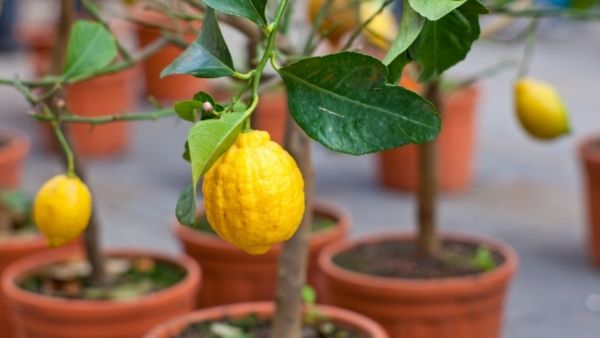
Dwarf lemon trees are a great way to satisfy that homegrown citrus fix. They do quite well in containers, and so long as they get ample sun and are protected from the cold, they can be grown indoors in pretty much any climate. Since they are relatively small, they can be integrated into space-constrained urban homesteads and larger farms alike.
Dwarf lemons trees produce between 10 and 20 fruits per year. Despite their small stature, they produce regular sized lemons. To bear fruit, a lemon tree must be 2-3 years old. Lemon trees can tolerate even poor soils but thrive in slightly acidic soil with good drainage.
8. Cantaloupes
Cantaloupes are hardy melons that make a great planting choice for homesteaders with enough space.
A variety of muskmelon, cantaloupes are known for their crunchiness and distinctively sweet flavor. Each cantaloupe plant will produce 4-8 melons, and on average, they mature in 80-90 days, though some quicker-maturing varieties finish in as little as 65 days.
By staggering planting times of these quicker varieties by a week or two, homesteaders can ensure a steady harvest throughout much of the year.
They tolerate temperatures ranging from 65-95° Fahrenheit and require a lot of moisture as they grow. Irrigation will be important for homesteaders in drier climates since cantaloupes will suck up a good deal of groundwater.
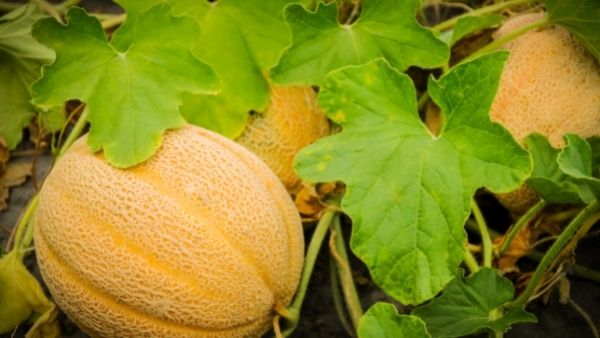
Mulch will help you retain extra water, so layer some on. Cantaloupes also consume a good deal of nutrients from the soil, so before planting, mix a few inches of compost into the topsoil to compensate. Once you set them up for success, growing cantaloupes is a breeze.
Melons need a lot of room to sprawl out, and cantaloupes are no exception. They should be spaced about 3 feet apart if grown on the ground. Homesteaders working with a small patch of land may want to grow them on trellises, in which case you need only a foot or so between plants.
9. Watermelon
Watermelons come in many varieties, ranging in fruit size from several pounds to tens of pounds. They take a while to grow, taking 80 days or more to fully mature. They tolerate a greater range of temperatures than cantaloupes do, being comfortable in hardiness zones 3-11.
Still, they need to be planted in soil that’s at least 70° Fahrenheit. Staggering planting, as with cantaloupes, is a common practice among planters.
Watermelon plants are best grown in small soil/compost hills in rows spaced 3-4 feet apart, with twice as much room between rows. Because they tend to go hog wild in whatever space they possibly can, homesteaders should prune watermelon vines regularly to keep them from choking out neighboring crops. Each watermelon vine will produce up to 4 melons, and having three plants, each with a few vines, per hill is typical. Even though they take up a great deal of space, they put out a whole lot of fruit.
Watermelon is a tasty, refreshing summer treat, especially when chilled. When you’re finished munching on the sweet, crunchy interior, the rind makes a great addition to the compost pile.
Because of their widespread popularity, commercially-minded homesteaders may want to grow some, as they’re nearly guaranteed to sell.
10. Blueberries
Blueberries grow on small- to medium-sized bushes. Blueberries are great for container growing but need a container of about 15 gallons. This can be a good alternative to in-ground planting if your soil doesn’t have the nutrients and minerals that blueberries need.
All blueberries require well-drained, acidic soil to thrive. Mulching around the base of the bush is highly recommended.
Blueberries are also self-pollinating, so you can plant a single bush and still get a good crop of fresh berries. Each blueberry bush will produce 5-7 pints of fruit per summer harvest. Blueberries are jam-packed with antioxidants, making them a favorite of health-minded homesteaders.
Popularly eaten fresh, some people like to make other goods out of blueberries. These include blueberry jams and jellies, pies and pastries, and wines. These secondary goods go for fairly high prices, making them great for homesteaders who are interested in selling their wares.
11. Raspberry
Raspberries are another berry-bearing bush that makes a colorful addition to your homestead. Like blueberries, they need good drainage and acidic soil. Unlike a majority of fruits, they do not require full sun and can grow well in partial shade.
They produce 1-2 quarts of raspberries per year. However, harvests vary in length between the more common summer-bearing variety and everbearing raspberries, which fruit in both the fall and the following summer. A mix of the two is recommended for homesteaders who want a steady source of raspberries.
Red raspberries are the most common, though black raspberries can be cultivated on the homestead. Black raspberries have more strict soil and nutrient needs and are typically only available for short periods commercially.
If you have the right conditions to grow them, try adding a bush or two to your homestead. If your soil isn’t quite right for raspberries of either type, they can be grown in large containers quite easily.
12. Currants
Currants are a great way to attract pollinators to your homestead while also producing a good deal of fruit.
Previously banned in many parts of the United States due to concerns over their role as disease vectors that threatened the lumber industry, currants are making a comeback. They are a relatively low-maintenance bush that puts out a lot of fruit each year.
Though federal bans were lifted due to the development of disease-resistant cultivars, some states and localities may still be banned, so check with your local Department of Agriculture to find out if it’s legal to plant currants on your homestead. Regardless, you should only plant disease-resistant varieties.
Currants are generally suited to northern climates and are frost tolerant, doing quite well in hardiness zones 3-8. They like slightly acidic soil with good drainage. It’s best to plant them in full sun with ample room, as they will produce berries for up to 40 years.
Plant currant bushes about 3-5 feet apart, with 8-10 feet between rows. Mature currant bushes will produce up to 4 quarts of berries each year, and currents can be frozen or made into jams or jellies for long-term storage.
13. Strawberries
Strawberries are probably the most popular berry and are easy to grow regardless of available space.
Strawberries like neutral to slightly acidic soil, doing best in loamy soil with a pH of 6-7. They also should have plenty of sunlight and good drainage. They do well in a wide range of climates, growing successfully in growing zones 3-11.
They can be sown in-ground or in containers, making them a great choice of fruit crop for both small- and large-scale homesteaders.
Strawberries are perennial plants and will grow back to bear more fruit in the spring after dying in the winter. Each plant will produce 1-2 quarts of strawberries each summer. They are most often planted as starters bought from a local nursery and typically need a year or so to become well-established and produce optimal yields of fruit.
June-bearing strawberries are sown 1.5-2 feet apart with rows spaced 4 feet. Everbearing varieties usually need less space than the sprawling summer varieties.
Strawberries are another best-selling fruit. They are popular on their own and sell quickly at grocery stores and farmer’s markets alike.
Homesteaders with the ingenuity and know-how might want to bake their strawberries into pastries, make them into jam or preserves, or even coat them in chocolate to set themselves apart.
14. Tomatoes
With numerous varieties of tomatoes suited to an equally broad array of conditions, tomatoes are a versatile addition to any homestead. They can be grown in containers or sown directly in the ground.
They mature in 60-80 days. Tomatoes need at least 6 hours of sun per day and prefer slightly acidic soil. Tomatoes are highly prone to disease and pest infestation, so consistent, attentive care is key to their success.
While all tomatoes can be temperamental, cherry tomatoes are generally the most forgiving and are a great variety to start with for beginners.
For more experienced growers, there are heirloom or heritage varieties that are both highly nutritious and more colorful. These tomatoes, however, have a shorter shelf life and less resistance to disease than newer varieties.
Tomatoes are great for an array of culinary applications. They are great in salads or eaten fresh. Fried green tomatoes are a classic Southern staple, and a couple of grilled slices of tomato on a grilled cheese can make an already good sandwich great.
Of course, stewed tomatoes make great pasta sauce or a base for chili. However you eat your tomatoes, you’ll be glad you grew some.




